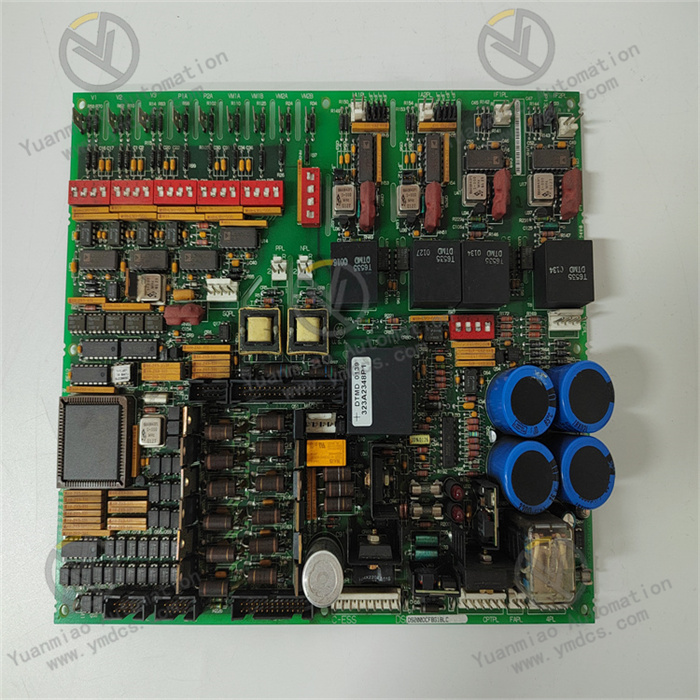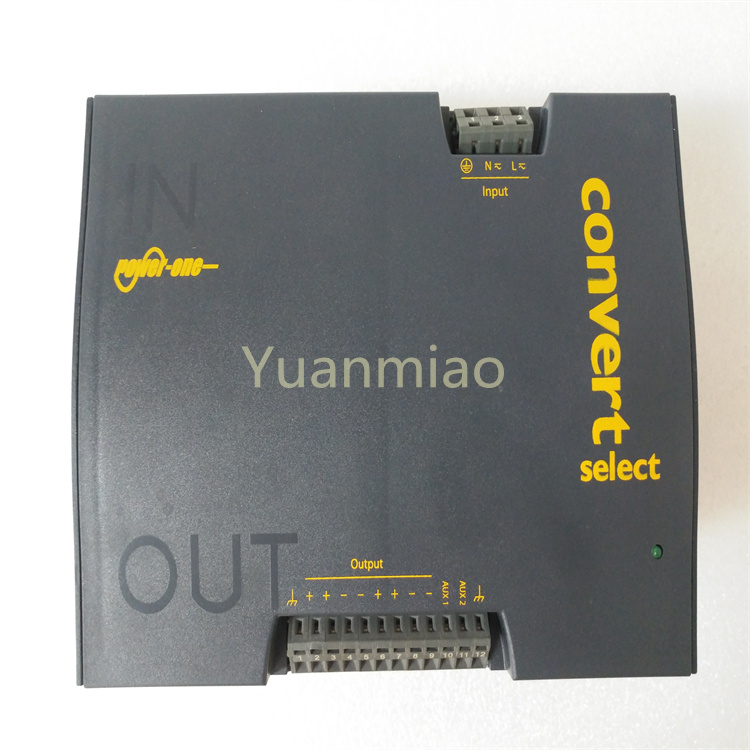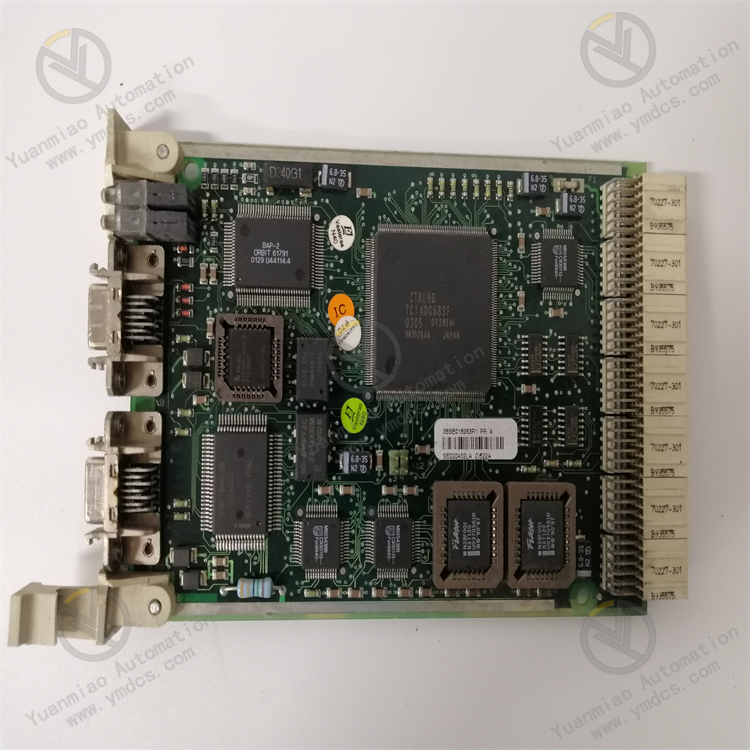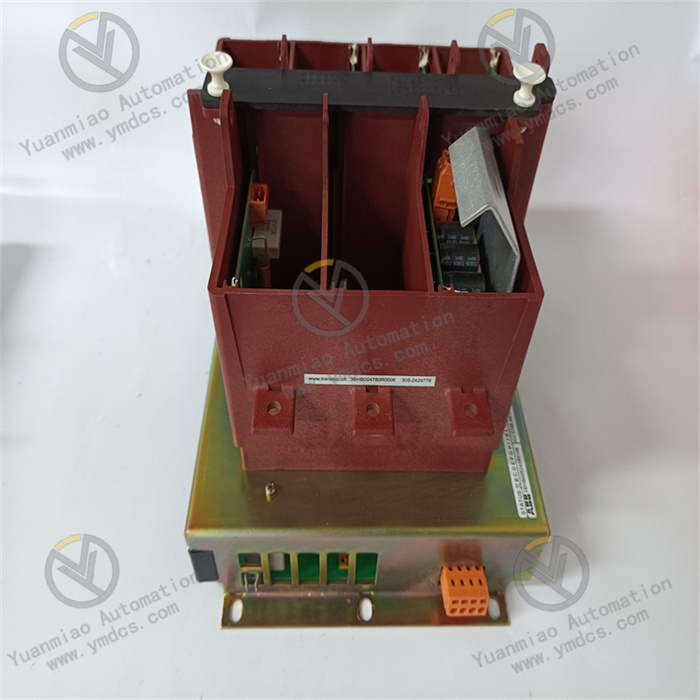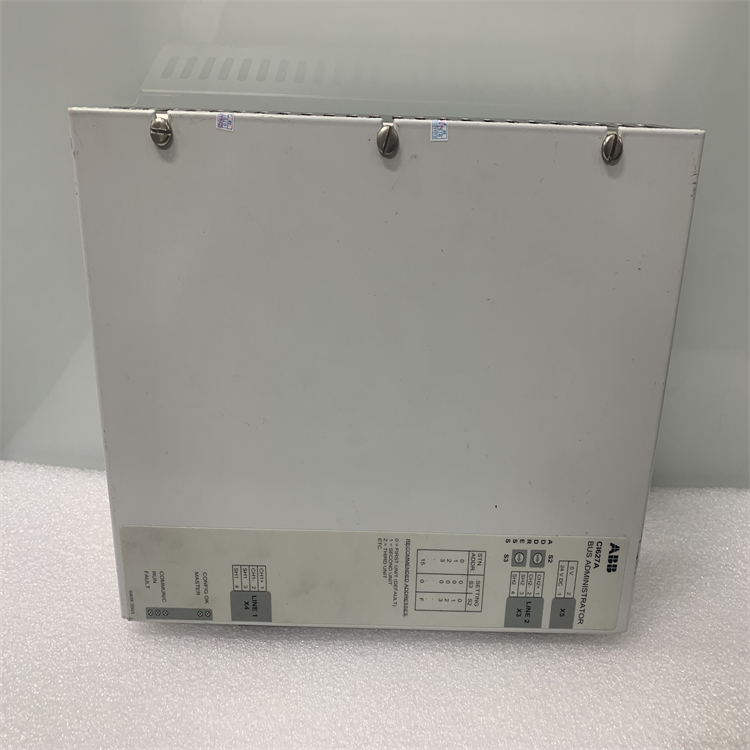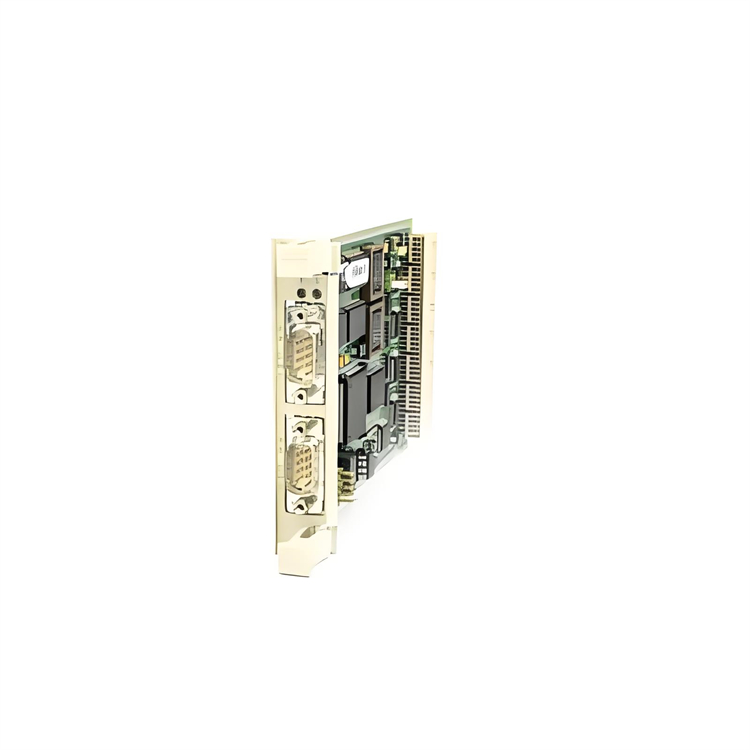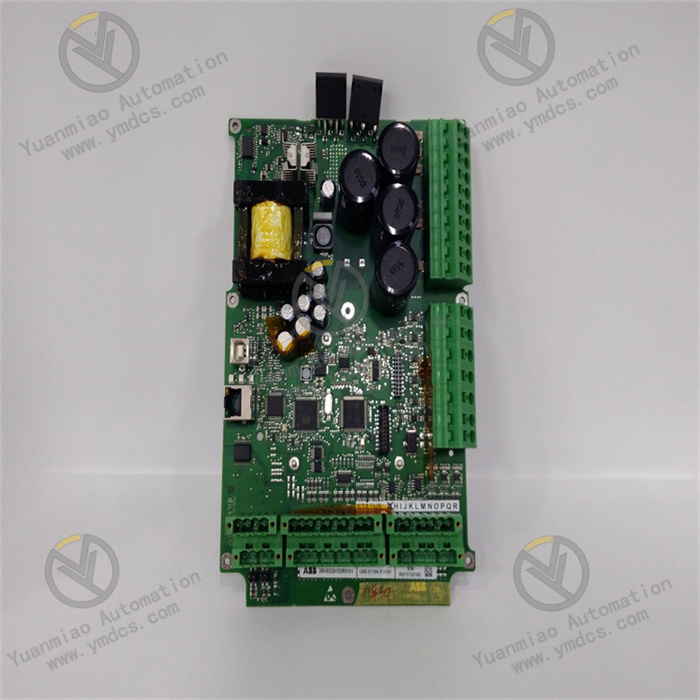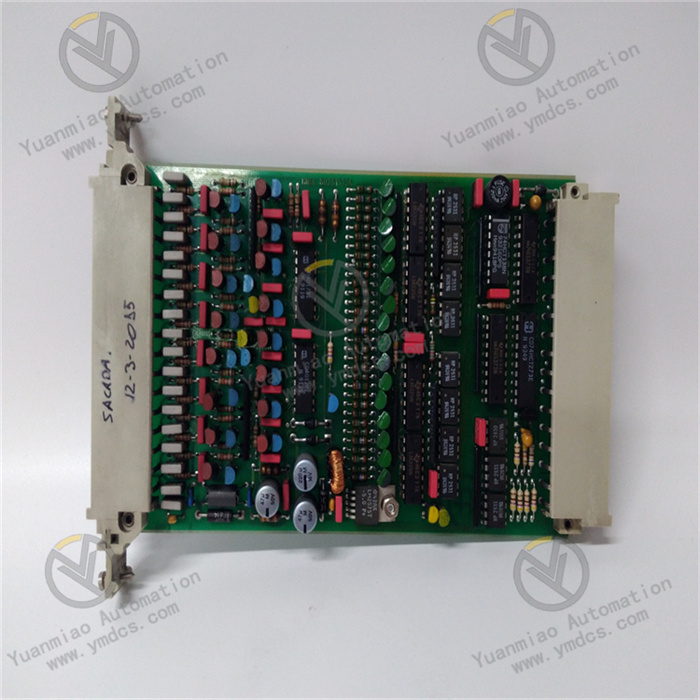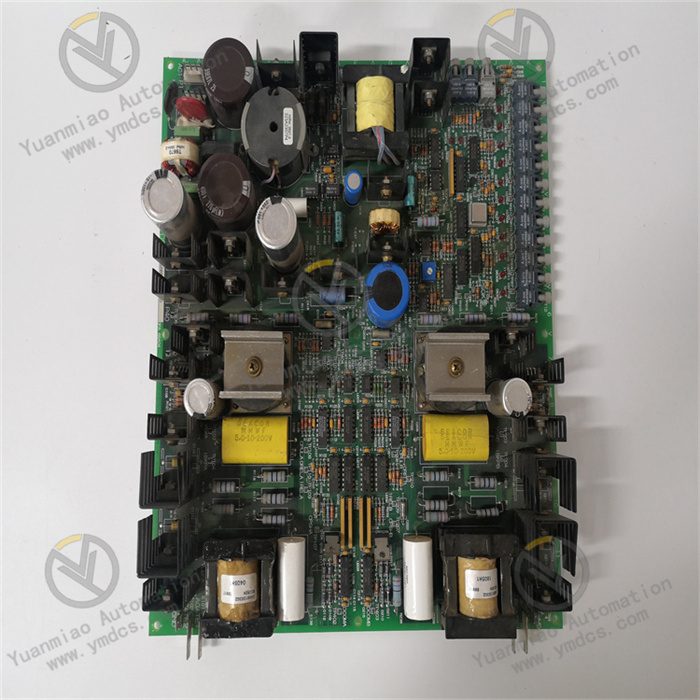Description
GE WES5302-150
I. Product Overview
GE WES5302-150 is mainly used to build an efficient industrial automation system, realizing precise control and real-time monitoring of various equipment in the production process. It can collect, organize, and preliminarily process signals from front-end devices such as sensors, switches, and buttons, and then transmit these data to the central control system to provide a basis for subsequent decision-making and command issuance. At the same time, it also receives control commands fed back by the central control system, and then drives external devices such as relays, solenoid valves, and motor starters to ensure that the entire industrial production process proceeds in an orderly manner according to the preset process.
II. Functional Features
High-speed data processing capability: GE WES5302-150 is equipped with a high-performance processor, which has excellent computing power and can quickly process a large amount of data from on-site equipment. Whether it is dense sensor data on the production line or multi-source information in complex process flows, it can perform calculations and analyses in a timely and accurate manner. For example, in the automated production line of automobile manufacturing, this module can quickly process data such as part assembly positions and equipment operating status fed back by sensors at various stations, ensuring the high-speed and stable operation of the production line and avoiding production stagnation or errors caused by untimely data processing.
Real-time monitoring and response: It supports real-time data collection and monitoring functions, and can track key parameters in the industrial process in real time. Once abnormal parameters or equipment failures are detected, it can respond quickly, trigger corresponding alarm mechanisms through preset logic, and adjust control strategies in a timely manner. For example, in the chemical production process, the temperature, pressure and other parameters of the reactor are monitored in real time. When the temperature exceeds the safety threshold, the module immediately issues an alarm and controls the cooling system to start to prevent danger.
(2) Flexible and Diverse Communication Capabilities
Rich communication protocol support: It is fully compatible with a variety of mainstream communication protocols, including Modbus TCP/IP, Modbus RTU, DNP3, IEC 61850, etc. This enables GE WES5302-150 to easily communicate and connect with devices and systems of different brands and types, breaking down communication barriers and realizing the interconnection of industrial networks. In a smart factory composed of equipment from multiple manufacturers, it can conduct data interaction with devices using the Modbus protocol through the Modbus protocol, and communicate with power system-related devices using the IEC 61850 protocol at the same time, ensuring the smooth flow of information in the entire factory network.
Multiple communication interface configurations: It is equipped with rich communication interfaces such as Ethernet, RS485, serial port, and CAN bus. The Ethernet interface can provide high-speed data transmission rate, meeting the communication needs of large data volume and high real-time performance, and is suitable for connecting upper computers, cloud platforms and other devices to realize remote monitoring and management; the RS485 interface, with its good anti-interference and multi-node connection capabilities, is often used in industrial sites to connect various sensors, instruments and other devices to build a stable industrial data collection network; the serial port and CAN bus interface also each have unique advantages, providing convenience for the connection and communication of specific devices, and enhancing the adaptability of the module in different industrial scenarios.
Rich communication protocol support: It is fully compatible with a variety of mainstream communication protocols, including Modbus TCP/IP, Modbus RTU, DNP3, IEC 61850, etc. This enables GE WES5302-150 to easily communicate and connect with devices and systems of different brands and types, breaking down communication barriers and realizing the interconnection of industrial networks. In a smart factory composed of equipment from multiple manufacturers, it can conduct data interaction with devices using the Modbus protocol through the Modbus protocol, and communicate with power system-related devices using the IEC 61850 protocol at the same time, ensuring the smooth flow of information in the entire factory network.
Multiple communication interface configurations: It is equipped with rich communication interfaces such as Ethernet, RS485, serial port, and CAN bus. The Ethernet interface can provide high-speed data transmission rate, meeting the communication needs of large data volume and high real-time performance, and is suitable for connecting upper computers, cloud platforms and other devices to realize remote monitoring and management; the RS485 interface, with its good anti-interference and multi-node connection capabilities, is often used in industrial sites to connect various sensors, instruments and other devices to build a stable industrial data collection network; the serial port and CAN bus interface also each have unique advantages, providing convenience for the connection and communication of specific devices, and enhancing the adaptability of the module in different industrial scenarios.
(3) Reliable System Stability
High-reliability hardware design: It adopts industrial-grade components and advanced circuit design to ensure the stable operation of the module in complex industrial environments at the hardware level. In terms of electrical performance, it has excellent anti-electromagnetic interference capability, which can effectively resist electromagnetic interference generated by various electrical equipment in industrial sites, avoiding data transmission errors or equipment misoperation. At the same time, its power management system has been optimized to adapt to a wide range of input voltage fluctuations, ensuring that the module can still work normally when the power supply is unstable. For example, in industrial scenarios with complex electromagnetic environments and large power supply fluctuations such as metallurgy and mining, GE WES5302-150 can operate stably, ensuring the continuity of the production process.
Fault diagnosis and self-repair function: It has a built-in perfect fault diagnosis mechanism, which can monitor its own operating status in real time. Once a fault is detected, it immediately conducts fault location and analysis, and informs the user through indicator lights, alarm signals, etc. In some fault cases, the module also has a certain self-repair capability, such as automatically restarting relevant functional modules and re-establishing communication connections, to minimize system downtime caused by faults and improve the reliability and stability of industrial production.
High-reliability hardware design: It adopts industrial-grade components and advanced circuit design to ensure the stable operation of the module in complex industrial environments at the hardware level. In terms of electrical performance, it has excellent anti-electromagnetic interference capability, which can effectively resist electromagnetic interference generated by various electrical equipment in industrial sites, avoiding data transmission errors or equipment misoperation. At the same time, its power management system has been optimized to adapt to a wide range of input voltage fluctuations, ensuring that the module can still work normally when the power supply is unstable. For example, in industrial scenarios with complex electromagnetic environments and large power supply fluctuations such as metallurgy and mining, GE WES5302-150 can operate stably, ensuring the continuity of the production process.
Fault diagnosis and self-repair function: It has a built-in perfect fault diagnosis mechanism, which can monitor its own operating status in real time. Once a fault is detected, it immediately conducts fault location and analysis, and informs the user through indicator lights, alarm signals, etc. In some fault cases, the module also has a certain self-repair capability, such as automatically restarting relevant functional modules and re-establishing communication connections, to minimize system downtime caused by faults and improve the reliability and stability of industrial production.
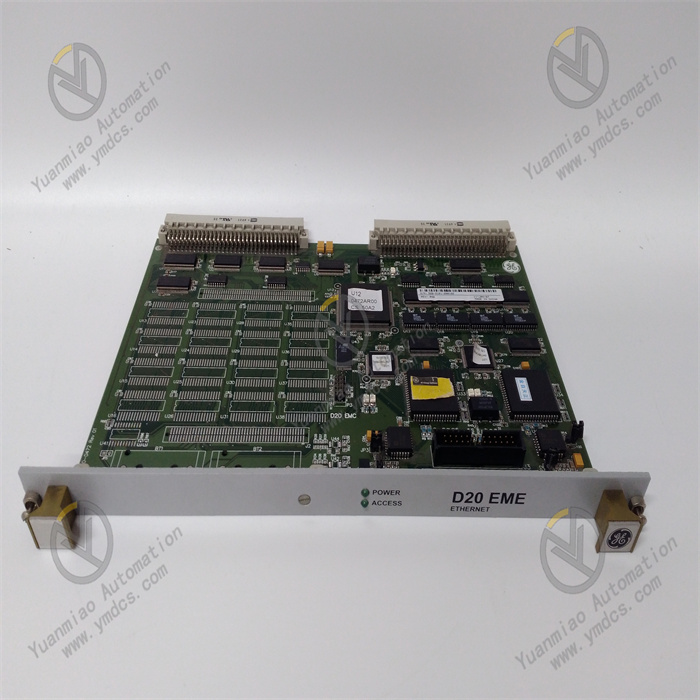
III. Technical Parameters
Input voltage range: It can usually adapt to a wide input voltage range, such as DC 9V to 36VDC or 36VDC to 75VDC and other different specifications (depending on the product version). This wide voltage adaptability enables it to be flexibly applied to industrial sites with different power supply conditions, whether it is small automation equipment powered by low-voltage DC or large industrial systems using higher-voltage DC power supplies, it can be stably connected.
Output voltage range: The output voltage range is generally 0.6VDC to 1.8VDC, which can accurately provide a stable working voltage for connected load devices, meeting the specific requirements of various sensors, actuators, etc. for the power supply voltage, and ensuring the normal operation of the equipment and the accurate transmission of signals.
Maximum input current: The maximum input current can reach 150A, with strong current-carrying capacity, which can meet the needs of connecting high-load equipment or equipment that requires a large current at startup, ensuring stable power supply for the equipment under various working conditions and guaranteeing the reliable operation of the system.
Electrical characteristics of communication interfaces: The Ethernet interface supports 10/100Mbps adaptive rate, which can automatically adjust the transmission rate according to the capability of the connected device to ensure efficient data transmission; the RS485 interface uses differential signal transmission, with good anti-interference performance, and the transmission distance can reach about 1200 meters (specifically related to cable quality and environment), which can meet the needs of long-distance communication in industrial sites; the serial communication rate can be flexibly configured within a certain range to adapt to the communication rate requirements of different devices; the CAN bus interface follows the CAN protocol standard, with high reliability and real-time performance, and the maximum data transmission rate can reach 1Mbps (the rate varies with the transmission distance).
(2) Physical Parameters
Dimensions: The module has a compact design, usually 130mm x 84mm x 19.5mm or 120mm x 60mm x 80mm, etc. (slight differences between different versions). The small size allows it to be easily installed in electrical control cabinets and equipment enclosures with limited space, saving valuable installation space, facilitating system integration and wiring, and is especially suitable for industrial automation equipment with strict space requirements.
Weight: It is relatively light, generally within a range that is convenient for transportation and installation, such as about 1.2kg (the specific weight depends on the actual product). This not only reduces the load requirements on structures such as mounting brackets, reduces installation difficulty, but also helps to improve the stability and reliability of the entire system, facilitating the handling and installation of equipment in different scenarios.
Installation methods: It supports multiple installation methods, common ones are rail mounting and panel mounting. The rail mounting method conforms to industrial standards, is easy to install, and can quickly fix the module on the standard rail of the industrial control cabinet, facilitating maintenance and replacement; panel mounting is suitable for some scenarios with high requirements on installation position and protection. By installing the module on the equipment panel, it is convenient for operators to debug and monitor, and can better protect the module from the external environment.
Dimensions: The module has a compact design, usually 130mm x 84mm x 19.5mm or 120mm x 60mm x 80mm, etc. (slight differences between different versions). The small size allows it to be easily installed in electrical control cabinets and equipment enclosures with limited space, saving valuable installation space, facilitating system integration and wiring, and is especially suitable for industrial automation equipment with strict space requirements.
Weight: It is relatively light, generally within a range that is convenient for transportation and installation, such as about 1.2kg (the specific weight depends on the actual product). This not only reduces the load requirements on structures such as mounting brackets, reduces installation difficulty, but also helps to improve the stability and reliability of the entire system, facilitating the handling and installation of equipment in different scenarios.
Installation methods: It supports multiple installation methods, common ones are rail mounting and panel mounting. The rail mounting method conforms to industrial standards, is easy to install, and can quickly fix the module on the standard rail of the industrial control cabinet, facilitating maintenance and replacement; panel mounting is suitable for some scenarios with high requirements on installation position and protection. By installing the module on the equipment panel, it is convenient for operators to debug and monitor, and can better protect the module from the external environment.
(3) Environmental Parameters
Operating temperature range: The operating temperature range is extremely wide, from -40°C to +85°C. This enables it to adapt to industrial environments under various extreme temperature conditions around the world, whether it is outdoor industrial facilities in cold regions, such as oil extraction equipment in the Arctic Circle, or industrial production workshops in hot environments, such as refining factories in desert areas, it can ensure the normal and stable operation of the module, ensuring that the industrial automation system is not affected by ambient temperature and realizing year-round continuous operation.
Humidity adaptation: It can work normally in an environment with a relative humidity of 0% to 95% (non-condensing). The excellent moisture-proof design enables it to effectively cope with humid environments such as factory workshops in rainy southern regions and underground distribution rooms, avoiding electrical short circuits, corrosion and other faults caused by humidity problems, prolonging the service life of the module, and ensuring the long-term stable operation of the system. Even in industrial plants in coastal areas with high humidity, GE WES5302-150 can operate stably, providing protection for industrial production.
Protection level: The protection level usually reaches IP20, which can effectively prevent dust and is suitable for installation in environments with relatively good protection such as control cabinets. If equipped with an additional protective shell, the protection level can be further improved, such as reaching IP65, which can effectively protect against dust and water spray from all directions, and can adapt to harsher industrial environments, such as dusty mining sites, chemical workshops with slight corrosive gases, etc., ensuring the reliable operation of the module in complex environments.
Operating temperature range: The operating temperature range is extremely wide, from -40°C to +85°C. This enables it to adapt to industrial environments under various extreme temperature conditions around the world, whether it is outdoor industrial facilities in cold regions, such as oil extraction equipment in the Arctic Circle, or industrial production workshops in hot environments, such as refining factories in desert areas, it can ensure the normal and stable operation of the module, ensuring that the industrial automation system is not affected by ambient temperature and realizing year-round continuous operation.
Humidity adaptation: It can work normally in an environment with a relative humidity of 0% to 95% (non-condensing). The excellent moisture-proof design enables it to effectively cope with humid environments such as factory workshops in rainy southern regions and underground distribution rooms, avoiding electrical short circuits, corrosion and other faults caused by humidity problems, prolonging the service life of the module, and ensuring the long-term stable operation of the system. Even in industrial plants in coastal areas with high humidity, GE WES5302-150 can operate stably, providing protection for industrial production.
Protection level: The protection level usually reaches IP20, which can effectively prevent dust and is suitable for installation in environments with relatively good protection such as control cabinets. If equipped with an additional protective shell, the protection level can be further improved, such as reaching IP65, which can effectively protect against dust and water spray from all directions, and can adapt to harsher industrial environments, such as dusty mining sites, chemical workshops with slight corrosive gases, etc., ensuring the reliable operation of the module in complex environments.
IV. Application Scenarios
Production line automation: In the production lines of various manufacturing industries such as automobile manufacturing, electronics manufacturing, and food processing, GE WES5302-150 plays a core control role. It connects various equipment on the production line such as robots, automated assembly equipment, and material conveying systems, and realizes the automated operation and precise control of the production line by transmitting equipment operating status information and control commands in real time. For example, in an automobile manufacturing workshop, when auto parts are transported to the assembly station, the sensor transmits the position signal to GE WES5302-150, and the module controls the robot to perform precise assembly according to the preset program, while monitoring parameters such as torque and position during the assembly process to ensure assembly quality and improve production efficiency and product quality.
Energy management: Energy consumption in manufacturing factories is huge, and GE WES5302-150 can be used to build an energy management system. It connects various energy monitoring equipment, such as electricity meters, water meters, gas meters, etc., collects energy consumption data in real time, and analyzes and processes the data. Through linkage control with production equipment, it realizes the optimal distribution and utilization of energy. For example, according to the production plan and equipment operating status, dynamically adjust the power output of the equipment to reduce energy consumption on the premise of ensuring production, achieve the goal of energy conservation and emission reduction, and improve the economic benefits and sustainable development capabilities of the enterprise.
(2) Energy Industry
Power system monitoring: In power system facilities such as power plants and substations, GE WES5302-150 is used to monitor the operating parameters of power equipment in real time, such as the voltage, current, frequency of generators, and the oil temperature and winding temperature of transformers. Through the analysis of these data, potential equipment faults can be found in time, and maintenance measures can be taken in advance to ensure the safe and stable operation of the power system. At the same time, it communicates with the power dispatching system to realize the reasonable distribution and dispatching of electricity, ensuring the reliability and stability of power supply and meeting the electricity needs of social production and life.
Oil and gas transmission: In the process of oil and gas exploitation and transmission, it is necessary to monitor and control parameters such as pipeline pressure, flow rate, and temperature in real time. GE WES5302-150 connects various sensors and actuators distributed along the pipeline, collects data in real time, and controls equipment operations such as valve opening and closing, pump start and stop according to preset logic. For example, when the pipeline pressure rises abnormally, the module immediately controls the safety valve to open for pressure relief, and starts the backup pump to adjust the flow rate, ensuring the safety and stability of the oil and gas transmission process and preventing accidents such as leaks.
Power system monitoring: In power system facilities such as power plants and substations, GE WES5302-150 is used to monitor the operating parameters of power equipment in real time, such as the voltage, current, frequency of generators, and the oil temperature and winding temperature of transformers. Through the analysis of these data, potential equipment faults can be found in time, and maintenance measures can be taken in advance to ensure the safe and stable operation of the power system. At the same time, it communicates with the power dispatching system to realize the reasonable distribution and dispatching of electricity, ensuring the reliability and stability of power supply and meeting the electricity needs of social production and life.
Oil and gas transmission: In the process of oil and gas exploitation and transmission, it is necessary to monitor and control parameters such as pipeline pressure, flow rate, and temperature in real time. GE WES5302-150 connects various sensors and actuators distributed along the pipeline, collects data in real time, and controls equipment operations such as valve opening and closing, pump start and stop according to preset logic. For example, when the pipeline pressure rises abnormally, the module immediately controls the safety valve to open for pressure relief, and starts the backup pump to adjust the flow rate, ensuring the safety and stability of the oil and gas transmission process and preventing accidents such as leaks.
(3) Chemical Industry
Process control: In chemical production processes such as petrochemicals and pharmaceuticals, precise control of reaction conditions is crucial. GE WES5302-150 connects sensors and actuators on various chemical equipment such as reactors, distillation towers, and centrifuges, monitors process parameters such as temperature, pressure, liquid level, and flow rate in real time, and precisely adjusts the equipment operating status according to preset process formulas and control strategies. For example, in pharmaceutical production, the temperature and pH value in the reactor are strictly controlled to ensure the stability and consistency of drug quality and guarantee the safety and effectiveness of drug production.
Automated management: The production process of chemical enterprises is complex, involving many equipment and links. GE WES5302-150 can be used as a core component of the automated management system to realize centralized monitoring and management of the entire production process. It aggregates data from various production links to the central control system, and managers can understand the overall production situation in real time through the monitoring interface, find problems in time and make decisions. At the same time, through integration with the Enterprise Resource Planning (ERP) system, it realizes the collaborative operation of production planning, material management, quality management and other links, improving the production efficiency and management level of the enterprise.
Process control: In chemical production processes such as petrochemicals and pharmaceuticals, precise control of reaction conditions is crucial. GE WES5302-150 connects sensors and actuators on various chemical equipment such as reactors, distillation towers, and centrifuges, monitors process parameters such as temperature, pressure, liquid level, and flow rate in real time, and precisely adjusts the equipment operating status according to preset process formulas and control strategies. For example, in pharmaceutical production, the temperature and pH value in the reactor are strictly controlled to ensure the stability and consistency of drug quality and guarantee the safety and effectiveness of drug production.
Automated management: The production process of chemical enterprises is complex, involving many equipment and links. GE WES5302-150 can be used as a core component of the automated management system to realize centralized monitoring and management of the entire production process. It aggregates data from various production links to the central control system, and managers can understand the overall production situation in real time through the monitoring interface, find problems in time and make decisions. At the same time, through integration with the Enterprise Resource Planning (ERP) system, it realizes the collaborative operation of production planning, material management, quality management and other links, improving the production efficiency and management level of the enterprise.
(4) Water Treatment Industry
Automated control of sewage treatment plants: In sewage treatment plants, GE WES5302-150 is used to control the operation of various equipment such as sewage lift pumps, grid machines, aerators, and dosing devices. By monitoring sewage quality parameters in real time, such as pH value, chemical oxygen demand (COD), ammonia nitrogen content, and equipment operating status, it automatically adjusts equipment operating parameters to ensure the efficient and stable operation of the sewage treatment process. For example, according to changes in sewage flow and water quality, it automatically adjusts the aeration volume of the aerator and the dosing volume of the dosing device to reduce energy consumption and chemical consumption on the premise of ensuring that sewage treatment meets standards, and improve the operating efficiency of the sewage treatment plant.
Automated control of sewage treatment plants: In sewage treatment plants, GE WES5302-150 is used to control the operation of various equipment such as sewage lift pumps, grid machines, aerators, and dosing devices. By monitoring sewage quality parameters in real time, such as pH value, chemical oxygen demand (COD), ammonia nitrogen content, and equipment operating status, it automatically adjusts equipment operating parameters to ensure the efficient and stable operation of the sewage treatment process. For example, according to changes in sewage flow and water quality, it automatically adjusts the aeration volume of the aerator and the dosing volume of the dosing device to reduce energy consumption and chemical consumption on the premise of ensuring that sewage treatment meets standards, and improve the operating efficiency of the sewage treatment plant.


